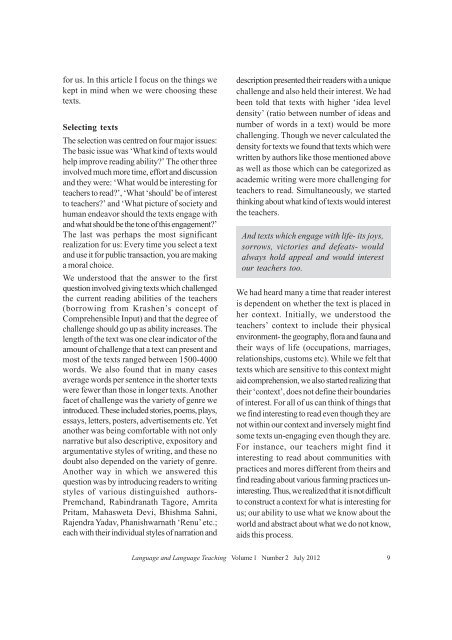Language and Language Teaching, Issue 2 - Azim Premji Foundation
Language and Language Teaching, Issue 2 - Azim Premji Foundation
Language and Language Teaching, Issue 2 - Azim Premji Foundation
You also want an ePaper? Increase the reach of your titles
YUMPU automatically turns print PDFs into web optimized ePapers that Google loves.
for us. In this article I focus on the things wekept in mind when we were choosing thesetexts.Selecting textsThe selection was centred on four major issues:The basic issue was ‘What kind of texts wouldhelp improve reading ability?’ The other threeinvolved much more time, effort <strong>and</strong> discussion<strong>and</strong> they were: ‘What would be interesting forteachers to read?’, ‘What ‘should’ be of interestto teachers?’ <strong>and</strong> ‘What picture of society <strong>and</strong>human endeavor should the texts engage with<strong>and</strong> what should be the tone of this engagement?’The last was perhaps the most significantrealization for us: Every time you select a text<strong>and</strong> use it for public transaction, you are makinga moral choice.We understood that the answer to the firstquestion involved giving texts which challengedthe current reading abilities of the teachers(borrowing from Krashen’s concept ofComprehensible Input) <strong>and</strong> that the degree ofchallenge should go up as ability increases. Thelength of the text was one clear indicator of theamount of challenge that a text can present <strong>and</strong>most of the texts ranged between 1500-4000words. We also found that in many casesaverage words per sentence in the shorter textswere fewer than those in longer texts. Anotherfacet of challenge was the variety of genre weintroduced. These included stories, poems, plays,essays, letters, posters, advertisements etc. Yetanother was being comfortable with not onlynarrative but also descriptive, expository <strong>and</strong>argumentative styles of writing, <strong>and</strong> these nodoubt also depended on the variety of genre.Another way in which we answered thisquestion was by introducing readers to writingstyles of various distinguished authors-Premch<strong>and</strong>, Rabindranath Tagore, AmritaPritam, Mahasweta Devi, Bhishma Sahni,Rajendra Yadav, Phanishwarnath ‘Renu’ etc.;each with their individual styles of narration <strong>and</strong>description presented their readers with a uniquechallenge <strong>and</strong> also held their interest. We hadbeen told that texts with higher ‘idea leveldensity’ (ratio between number of ideas <strong>and</strong>number of words in a text) would be morechallenging. Though we never calculated thedensity for texts we found that texts which werewritten by authors like those mentioned aboveas well as those which can be categorized asacademic writing were more challenging forteachers to read. Simultaneously, we startedthinking about what kind of texts would interestthe teachers.And texts which engage with life- its joys,sorrows, victories <strong>and</strong> defeats- wouldalways hold appeal <strong>and</strong> would interestour teachers too.We had heard many a time that reader interestis dependent on whether the text is placed inher context. Initially, we understood theteachers’ context to include their physicalenvironment- the geography, flora <strong>and</strong> fauna <strong>and</strong>their ways of life (occupations, marriages,relationships, customs etc). While we felt thattexts which are sensitive to this context mightaid comprehension, we also started realizing thattheir ‘context’, does not define their boundariesof interest. For all of us can think of things thatwe find interesting to read even though they arenot within our context <strong>and</strong> inversely might findsome texts un-engaging even though they are.For instance, our teachers might find itinteresting to read about communities withpractices <strong>and</strong> mores different from theirs <strong>and</strong>find reading about various farming practices uninteresting.Thus, we realized that it is not difficultto construct a context for what is interesting forus; our ability to use what we know about theworld <strong>and</strong> abstract about what we do not know,aids this process.<strong>Language</strong> <strong>and</strong> <strong>Language</strong> <strong>Teaching</strong> Volume 1 Number 2 July 2012 9
















